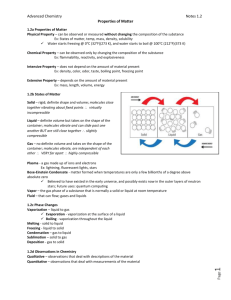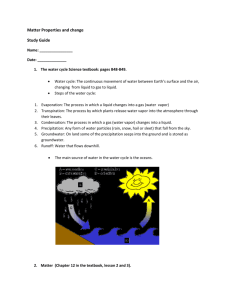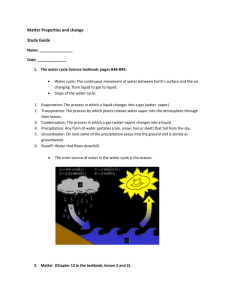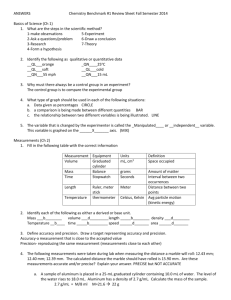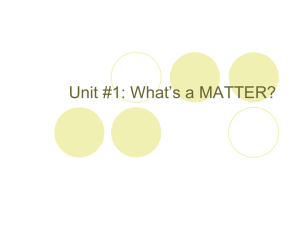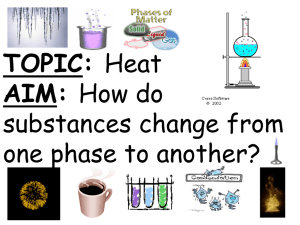Matter Vocabulary Words
advertisement
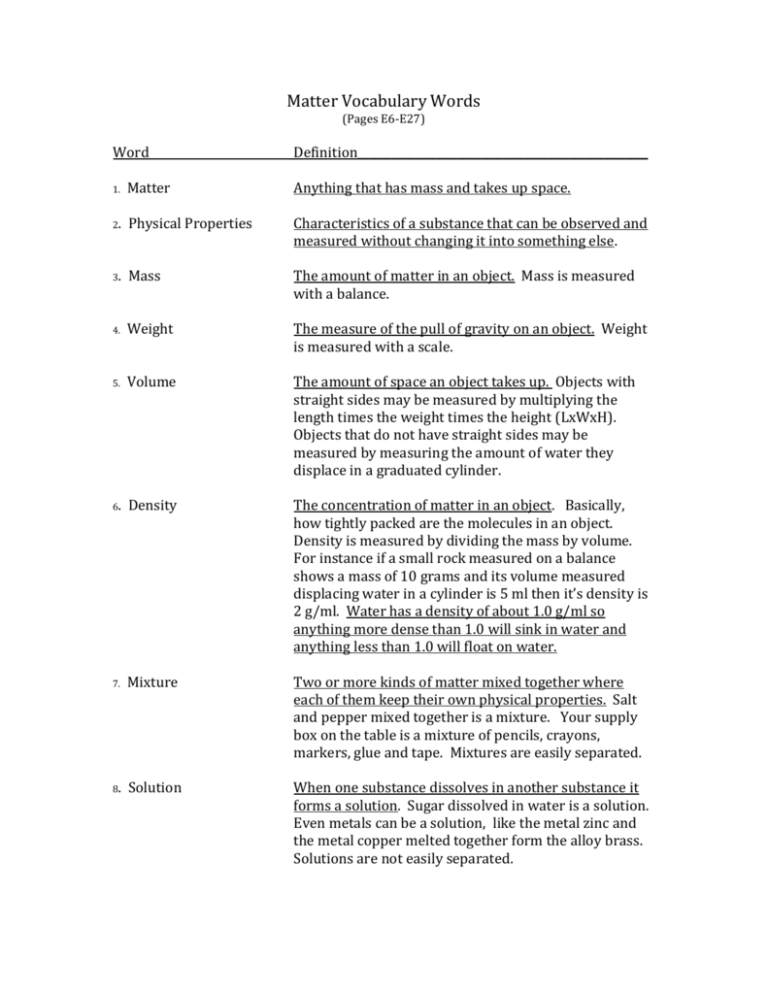
Matter Vocabulary Words (Pages E6-E27) Word Definition____________________________________________________ 1. Matter Anything that has mass and takes up space. 2. Physical Properties Characteristics of a substance that can be observed and measured without changing it into something else. 3. Mass The amount of matter in an object. Mass is measured with a balance. 4. Weight The measure of the pull of gravity on an object. Weight is measured with a scale. 5. Volume The amount of space an object takes up. Objects with straight sides may be measured by multiplying the length times the weight times the height (LxWxH). Objects that do not have straight sides may be measured by measuring the amount of water they displace in a graduated cylinder. 6. Density The concentration of matter in an object. Basically, how tightly packed are the molecules in an object. Density is measured by dividing the mass by volume. For instance if a small rock measured on a balance shows a mass of 10 grams and its volume measured displacing water in a cylinder is 5 ml then it’s density is 2 g/ml. Water has a density of about 1.0 g/ml so anything more dense than 1.0 will sink in water and anything less than 1.0 will float on water. 7. Mixture Two or more kinds of matter mixed together where each of them keep their own physical properties. Salt and pepper mixed together is a mixture. Your supply box on the table is a mixture of pencils, crayons, markers, glue and tape. Mixtures are easily separated. 8. Solution When one substance dissolves in another substance it forms a solution. Sugar dissolved in water is a solution. Even metals can be a solution, like the metal zinc and the metal copper melted together form the alloy brass. Solutions are not easily separated. Solubility Has the ability to be dissolved. Sugar and salt have the ability to be dissolved, but pepper does not. 10. Balance A balance measures mass. Two kind of balances you should be familiar with “The Equal Arm Balance” where the mass of one object is measured against the mass of another object and “The Triple Beam Balance” where the mass of an object is measured against the mass of three sliders (100 g, 10 g and 1 g) already programmed into the balance. 11. Scale A scale measures weight. There are many types of scales from your bathroom scale to a small spring scale. 12. States of Matter Most matter exists has a solid, liquid or a gas. The state the matter is in depends on the amount of heat added to the object. Water, when its very cold, below freezing, it changes into a solid (ice) when it gets above freezing it changes into a liquid (water) and starts to change into a gas (water vapor). Changing the state of matter are only physical changes it does not change the substance. Water is still water whether it is a solid, liquid or gas. 13. Solid Matter that has a definite shape and a definite volume. Basically, its matter that has its own shape and you can measure its volume. Molecules in solids stay close together and shake in place. 14. Liquid Matter that does not a definite shape but has a definite volume. Basically, it has the shape of whatever is holding it, but you can measure its volume. Molecules in liquids slide back and forth by one another. 15. Gas Matter that does not have a definite shape and does not have a definite volume. Basically, it has the shape of whatever is holding it and its volume is very hard to measure. When you blow up a balloon and you think its full of air you can still put a little more air in it. Molecules in gases move far apart and move very fast. Graduated Cylinder A clear tube that is marked in milliliters. It is used to measure volume. 9. 16. 17. Law of Conservation of Matter Matter is neither created nor destroyed during a physical or chemical change. It is only changed into something else. 18. Evaporation When the molecules begin to heat up they start to evaporate or turn in a gas. Like water changing into water vapor. Evaporation is the opposite of condensation. 19. Condensation This occurs when a substance changes from a gas back into a liquid. Like water changing from a water vapor back into a liquid. This happens when the substance starts to cool or lose its heat energy. Like water vapor forming on the outside of a glass of ice water. Condensation is the opposite of evaporation. 20. Sublimation A solid changing directly into a gas. 21. Boiling Changes a liquid into a gas by adding heat energy to over a 100 degrees C. Water boils at 100 degrees Celsius. 22. Freezing Changes a liquid into a solid by taking away heat energy. Water freezes at 0 degrees Celsius. 23. Melting Changes a solid into a liquid by adding heat energy. Water begins to melt at the same temperature it freezes 0 degrees Celsius. 24. Physical Changes Changes in matter where no new substances are made or formed. Tearing paper in half is a physical change because you changed it by tearing it, but it is still paper, nothing new was made. 25. Chemical Changes Changes in matter in which a new substance is formed. Burning paper is a chemical change, but because when the paper burned in formed carbon or ash. 26. Reactivity The ability some substances have to react chemically with other substances. When a substance changes color or gets hot or produces light or forms a gas when mixed with another substance then it having a chemical reaction to that substance. When a candle wick is burning a chemical reaction is taking place because you see light and smoke (gas) and carbon is formed.

